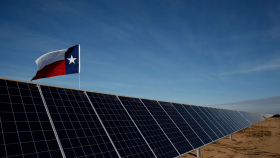The new state senator from California’s 11th District, Scott Wiener, has proposed a potentially historic bill, S.B. 71. This legislation would require, for new residential and commercial buildings of 10 stories or less within the state, that at least 15 percent of the roof area be fully equipped and installed for solar power. The source of the solar power may be either photovoltaic (PV) or solar-heated water (solar thermal). California’s current law merely requires that 15 percent of each roof of such buildings be “solar ready,” that is, that the roof space must be unshaded and free of obtrusions.
The proposal is modeled on a San Francisco ordinance that Wiener introduced last year, when he was a member of the city’s Board of Supervisors. (Three other California cities currently require solar on new buildings: Lancaster, Sebastopol and Santa Monica.) If S.B. 71 passes, the law would make California the first state in the nation to require solar power on the roofs of all new (non-skyscraper) buildings. California is committed to cutting emissions by 2030 to 40 percent below 1990s levels, as well as obtaining half of its energy from renewable sources. California remains the leading state for solar in the nation: this article claims that it became the first state ever to add more than 1GW of utility-scale PV solar power in a single fiscal quarter, in the third quarter of 2016.
There has been speculation that the bill might face more resistance in Sacramento than did the San Francisco ordinance, which passed the Board of Supervisors unanimously. Anonymous sources for this article worried that, if the bill passed, the cost of adding solar might be passed along to buyers in California’s housing market, which is already two-and-a-half times more expensive than the national average. This added cost, they reasoned, could price people in low-income areas out of the market entirely.
However, Wiener, who serves on the Energy, Utilities and Communications Committee in the state senate, denies that there is a cost problem. Solar power, he said, is “not a significant cost. It either pays for itself over time or you don’t even have to own the panels. You can have a third party come in and own and maintain the panels. That’s why we got little pushback from the development community in San Francisco [for the original ordinance].”
An article by investment website Motley Fool concurs with this view: “Mandating solar on new buildings would be a huge boost for the solar industry, but it would have an ancillary benefit of being much cheaper than solar through traditional sales channels… [Knowing] that new buildings have to have solar would help lower sales costs, and having the cost of solar rolled into a mortgage would lower financing costs, as well. The result should be a combination of lower costs for solar buyers and/or higher margins for installers.”
Sarah Rose, CEO of the California League of Conservation Voters, said: “President-elect Trump has made it clear he will work to roll back the national progress we’ve made on clean power. Now is the time for California to lead on expanding usage of solar power.”
“We must move past the era of dirty power that threatens our natural world and endangers everyone who lives on this planet,” said Wiener. “Requiring solar on new rooftops will keep California on an aggressive path towards a clean energy future and continue our fight against climate change.”





